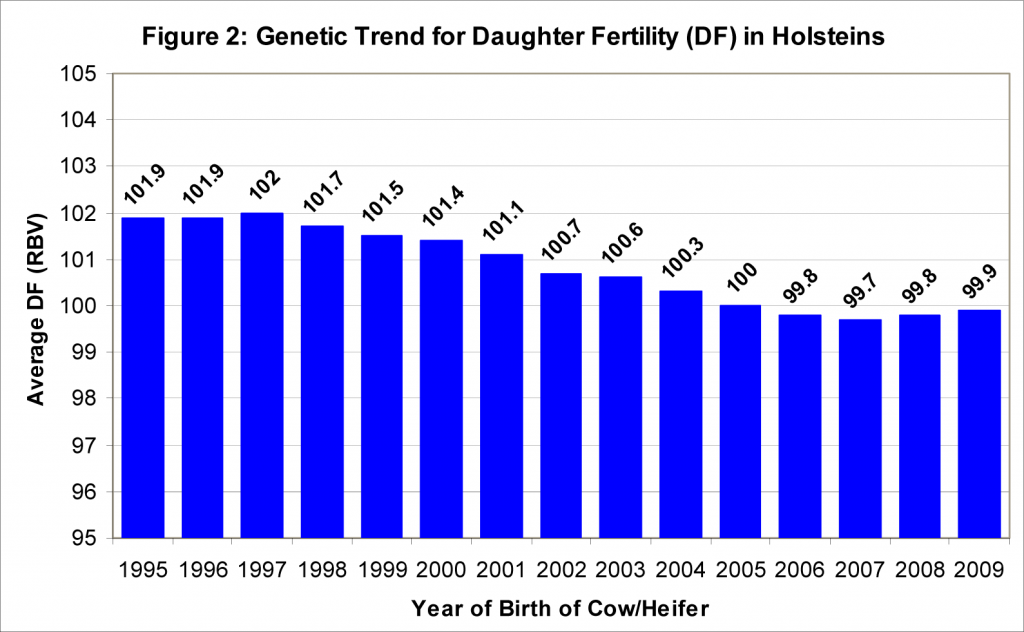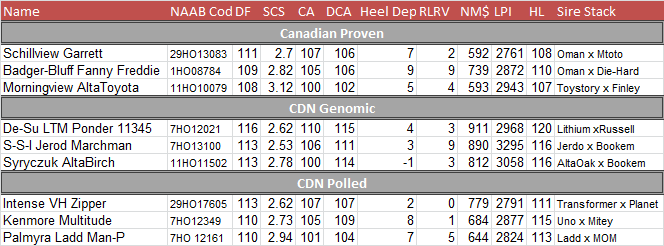If you were to describe the perfect program to achieve top female fertility in your herd, what would it be? Would your program include heifers calving at 22 months of age and every 11-13 months thereafter until lifetime production reaches 275,000 lbs (125,000 kgs) of milk? For decades breeders have heard that they can’t breed for fertility. It’s all management and nutrition. Well that story is changing. Let’s examine how genetics can play a role in improved fertility in a herd.
The Current Scenario
The CDCB (Council on Dairy Cattle Breeding) has summarized the following current reproduction information on the current US dairy cattle.
- Holstein cows take 2.5 breedings per conception. Jerseys take 2.2.
- Holstein cows average 80 days in milk before they are bred. Jerseys average 77 days.
- Average calving interval for Holstein cows that calve back is 13.8 months. Jerseys average 13.0 months.
- Average conception rate for Holstein cows is 32%. Jerseys average 41%.
- Average age at first calving in Holsteins is 26 months. Jerseys average 23.5 months.
These stats for Holsteins and Jerseys are provided for breeders to benchmark their herds, not to start a breed war. In five years’ time even if a Holstein herd was able to achieve the current Jersey average it will not be good enough. The three biggest factors that stand out from these stats and that are in need of correction are: 1) days to first breeding; 2) number of breedings before conception; and 3) age at first calving.
As it turns out the reproductive performance of North American dairy cows and herds reached their lowest level in 2007 and since then there has been minor genetic improvement.
Breeders Must Address Fertility
An attitude shift is needed. We must move from tolerance of fertility to awareness that genetics plays a role. Not all breeders have accepted the need for change. The Bullvine analysed the sires with the most progeny registered with Holstein US over the past two weeks and found that nine, yes nine, of the top twenty had negative genetic ratings for Daughter Pregnancy Rate (DPR). In fact two sires had significant negative ratings of -2.5 and -3.5. In addition four of the twenty had only slightly positive ratings. In total 13 of the top 20 sires were not breed improvers for DPR. That is significant!
Some breeders have paid attention to the management side of fertility and have increased their pregnancy rate by aggressive heat detection, by using professional A.I. reproduction specialists (Read more: Artificial Insemination – Is Doing It Yourself Really Saving You Money?) by installing heat detection devices or by using hormone level monitors (Read more: Better Decision Making by Using Technology). However from the latest reports from milk recording, half the herds have a pregnancy percent of less than 15%. And only 10% of herds have a pregnancy rate of 21% or more. Clearly more attention needs to be paid to getting cows and heifers pregnant.
Genetic Tools to Aid with Fertility
Daughter Pregnancy Rate (USA) and Daughter Fertility (Canada) are the primary genetic evaluation ratings to use when selecting for improved female fertility. These indexes are created using data from insemination, milk recording and type classification.
However there are eleven other genetic ratings that have some influence on reproduction. Individually they may not be significant but collectively they can contribute to reproductive problems or solutions.
- Calving Ease – difficult births delay cows coming into heat
- Maternal Calving Ease – normal delivery benefits – cow, calf and staff
- SCC – cows with mastitis are less likely to conceive
- Feet – problem cows are not mobile and do not show heats
- Rear Legs Rear View – cows that toes out are not as mobile
- Milk Yield – high milk yield stresses cows. Breed for high fat and protein yields on lower volumes of milk.
- Body Condition Score – high yielding cows that retain body condition are more fertile
- Persistency – high lactation yielding cows that have flatter lactation curves put less strain on their bodies
- Inbreeding – inbreeding negatively affects reproduction
- Haplotypes – information is now coming available to show that certain haploids hinder reproduction
- Semen Conception Rate – although not a genetic rating, low fertility semen should be avoided
Those are the tools available today. We can expect that, with the current research into genomics and reproduction, there will be new ratings to assist with breeding more reproductively sound animals in the future.
Selection Matters
The Bullvine recommends that after breeders short list the sires they intend to use that they eliminate sires that do not have a DPR over 1.0 or a DF over 103. Yes, female fertility is included in TPI, NM$ and LPI but the emphasis on fertility in these total merit indexes is not high enough to result in major genetic improvement for fertility. The following lists of bulls are examples of bulls that significantly improve total merit as well as female fertility.
Table 1 Top Ranking US Sires by Daughter Pregnancy Rate
Table 2 Top Ranking CDN Sires by Daughter Fertility
Action Plan
It is important for both herd viability and sustainability that the following steps be followed.
- Do not use bulls that are genetically inferior for reproductive traits.
- Genomically test heifer calves. Eliminate reproductively inferior cows and heifers.
- Include genomic reproductive information when correctively mating females.
- Use heat detection devices, hormone level monitoring equipment or intensive staff heat detection.
- Use herd management software and herd protocols to assist with reproductive management.
- Ensure that animal housing and animal grouping result in healthy animals
- Feed cows and heifers according to their performance and reproductive needs
- Employ staff training and education program for reproduction.
The Bullvine Bottom Line
The genetic attention starting to be given to female reproduction on dairy farms is long overdue. The first step for breeders is to include reproduction in your herd genetic improvement plan (Read more: What’s the plan?). In as little as five years, by following a progressive proactive plan, breeders will significantly reduce their losses due to reproduction.
Get original “Bullvine” content sent straight to your email inbox for free.
[related-posts-thumbnails]





















Leave a Reply
You must be logged in to post a comment.